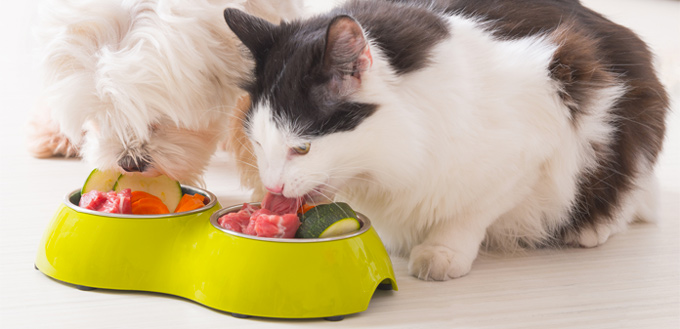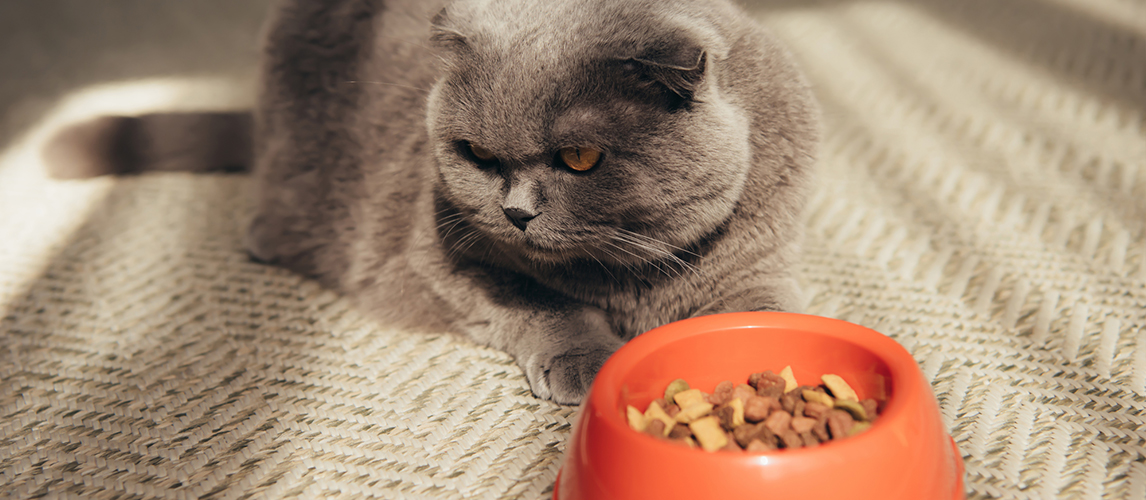Cats are one of the most delicate creatures around today. They are not only fussy and purry, but also adorable and cuddly. And obviously, as a cat lover, you want your felines to be in the best of health always.
Now, many of us like to eat raw foods, especially in the form of salads. So, while you nibble away your carrots and celery, can your cat have any part of it?

Can You Give Raw Foods to Your Cat?
Before going into the question, we should understand what are raw foods from a cat’s diet perspective. In general, raw food for the cat means uncooked animal muscle meat, bones and organ meat, other than maybe your carrots and celery occasionally.
This food is called the “Bones and Raw Food” or BARF in short. Some people even prefer to call it biologically appropriate raw food because this is exactly what the cat would eat in the wild. If you look at bigger cats like tigers (yes, they belong to the cat family!), they eat bones and raw animal meat when they hunt. This means, biologically, your cat can handle these foods and this is probably why some people think this is the biologically appropriate diet for your cats.
Why Should You Give Raw Foods?
There are many reasons to put your cat on a BARF diet, the most prominent of which is that this is the diet they are genetically predisposed to like and digest. In other words, the cat’s digestive system is designed to process these foods and take nutrition from them, instead of the many cat foods that are available commercially today.
Despite popular opinion on cat food, your cats really don’t need much carbohydrate in their diet. In fact, they can process only small amounts of carbohydrates and the rest is either excreted or creates digestive trouble for them.
Instead, they thrive well on high protein food and lots of water-soluble foods – both of which are found in raw meat. When you cook this meat, it reduces both protein content as well as moisture, and this is why it is better to feed it raw for your cats.
Well, before you jump in to fill your cat’s bowl with raw foods, here is what you need to know about the possible problems that come with it.
Is It Safe for Your Cats?
The opponents of raw food diet vouch that raw foods cause more harm than good for your cats. They argue that though cats were used to eating raw meat, the many centuries of domestication ahs altered their eating patterns.
Though this argument may sound valid, it has not been backed by research. That said, there are definitely a few problems that come with feeding your cat raw foods, the most prominent of which is the spread of pathogens like Salmonella and e.coli.
Presence of Pathogens
When you cook food, many of these disease-causing pathogens are killed in the process. But when you feed it raw, these pathogens remain and in turn, they can cause havoc to your cat’s health. Some of these infections could even be life-threatening for your cats.
Spread of Pathogens
Another potential problem that comes with feeding raw food to your cat is cross contamination. The pathogens present in the cat’s food can harm not just the cat, but everyone else in your house. As the cat moves from room to room, it is sure to lick on different surfaces and this spreads the pathogens. Also, when you store or prepare raw diet food on counter-tops, the pathogen from the food sticks to these surfaces. They can even be present in your cat’s fecal matter and on its face. So, the next time you rub your cat against your face, these pathogens are transmitted to you.
Disliked by a Few Breeds
The second aspect is not all cats can process raw food. This again goes back to the argument that cats have been domesticated and can’t process raw food like their counterparts in the wild. There is no scientific evidence, but some cat breeds are known to dislike raw food.

Bones
Another danger from giving raw food is the presence of small whole bones. These bones can enter the digestive tract of the cat and can cause gastrointestinal issues. Sometimes, it can obstruct the air pathways, thereby making it difficult for your cat to breathe. In the worst case, it can even suffocate your cat right away.
When your cat has to chew on small bones, it can cause oral problems as well. This problem is more likely if you’re going to feed your cats with raw food for the first time and it is used to eating soft food in the past.
To avoid these problems, you can ground the bones, if you’re going to make the food at home.
Balanced Foods
One of the mistakes that many cat owners do is that they do not provide a balanced diet with raw foods. Though protein is one of the major group of foods that your cat needs, it also needs carbohydrates and fats in smaller quantities. Also, there are other small nutritional values in the form of vitamins and minerals that your cat needs for a healthy body.
So, if you feed just raw meat and bones, it is not enough. You need to be aware of the calorific value of what you serve, along with what it contains. Eating meat alone is not going to give your cat all the nutrients it needs. You need to add a few other ingredients to make it a balanced meal.
It is best to check with your veterinarian on the right foods for your breed of cat. Get a list of the possible foods that you can serve raw, mix and match them to ensure that they get a wholesome meal every time. Some of the possible ingredients that have been recommended by many cat nutritionists are:
- Raw and moist meat from organs and muscles, such as poultry, rabbit and fish
- Raw bones, preferably grounded
- Eggs
- Supplements
If making this food is going to be too much for you, try commercially available raw foods for cats as they tend to be balanced. The added advantage with commercially available foods is that they are frozen to prevent the growth of pathogens. However, you need to handle these diets also safely, as freezing doesn’t eliminate all the pathogens.
So all this discussion boils down to the same question – should you feed your cat raw food or not? The answer is mostly a yes. If you’re going to feed for the first time, do it in small quantities and see if your cat likes it. Also, wait for 48 hours to see if there is any allergic reaction on your cats. If there are no allergies and your cat loves them, go ahead and feed your cat the raw foods it likes.
Precautions
Though you can put your cat on a diet of raw foods, here are some aspects to keep in mind.
- If you’re making this food at home, make sure you do it in a contained part of your house, preferably in your backyard. This way, the pathogens from the food do not affect the rest of your family members.
- Sanitize the cooking area with bleach when you’re done preparing the food.
- Always wear gloves when you’re handling raw meat, again to prevent the pathogens from getting to your skin and through it, to your body.
- It is better to handle frozen food than fresh raw food.
- Buy from a reliable source, so you can be assured of the quality of the food you buy.
- Feed your cat in a place that is easy to clean and sanitize. This means no carpets or upholstery. Also, make sure you always sanitize the area after your cat is done eating.
- Sanitize food bowls. Preferably clean it with a combination of water and bleach.
Related Post: Food Bowls For Cats
Recipes
Now that you’ve decided to feed raw food to your cat and have taken care of the precautions, here are some sample cat food recipes to get you started.
Breakfast
- Take one spoon of milk powder and mix it with water.
- Beat three medium eggs
- You can make a pancake or soak raw meat in it for an hour and serve.
Lunch
- Take four ounces of canned or fresh tuna
- Add two eggs to it and beat everything well together
- Crush and ground two small pieces of bone and add to this mixture
- Add a multivitamin supplement and pour it in your cat’s bowl.
We hope these diets give you an idea of what type of foods you should add to your cat’s diet.
In short, it is a good idea to feed raw food to your cat, provided you follow the above precautions and buy it from a reliable place.
Sources:
- Can Cats Have a Raw Food Diet?, PetMD
- Cats and the Raw Food Diet, Pets WebMD
- Raw Diets: A Healthy Choice or a Raw Deal?, The Clinical Nutrition Service







